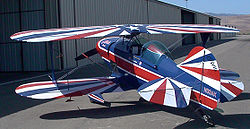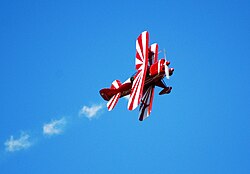Design and development
Curtis Pitts began the design of a single-seat aerobatic biplane in 1943–1944. [3] The design has been refined continuously since the prototype first flew in September 1944; however, the current Pitts S-2 still remains quite close to the original in concept and in design. [4]
Several of the aircraft that Curtis Pitts built had a picture of a skunk on them and were called "Stinkers". After she bought it, aerobatic performer Betty Skelton called the second aircraft that Curtis built, "Little Stinker". The prototype S-2, which was the first two-seat Pitts, was "Big Stinker", the prototype Model 11 (later called S-1-11B) was "Super Stinker", and the prototype Model 12 was the "Macho Stinker". [5] [6]
In 1962 Curtis Pitts set up Pitts Enterprises to sell plans of the S-1C to homebuilders. [7]
Current versions
Certified versions of the Pitts are now produced by Aviat Aircraft in Afton, Wyoming. It is available as the S-1 single-seater with an up to 200 hp (150 kW) flat-4 Lycoming engine and a 17 ft 4 in (5.28 m) wingspan, or as the S-2 two-seater variant featuring a 260 hp (194 kW) flat-6 Lycoming and a 20 ft (6.1 m) wingspan. Pitts Specials have been equipped with engines of up to 450 hp (338 kW). [1]
Plans for the single-seat Pitts S-1S are also available from Aviat Aircraft. The S-1C and derivative S-1SS plans and kits are supplied by Steen Aero Lab in Palm Bay, Florida. Many hundreds of homebuilders have successfully completed and flown the Pitts since plans became available in 1960. [8]
Operational history
All single-seat (S-1) and two-seat (S-2) Pitts Specials are variations of the basic design from 1944.
The aircraft was popularized by Betty Skelton, Caro Bayley, and other air show performers, which led to the offering of plans in 1962. [7]
Pitts produced limited numbers of aircraft during the 1940s and 1950s. The Pitts Special became the standard by which all other aerobatic aircraft were judged. After a number of homebuilt aircraft were produced from rough hand-drawn plans produced by Pitts, more professionally drawn plans went on sale in 1962. While many homebuilt aircraft were built in the 1960s, earning the S-1 a reputation as an excellent aerobatic aircraft, Pitts worked on the design of a two-seat aerobatic trainer version, the S-2, which first flew in 1967 and gained its type certificate in 1971. Factory-built aircraft produced by the Aerotek company at Afton, Wyoming were joined in production by the single-seat S-1S in 1973. [9] [10]
In 1972, the US Aerobatic Team won the World Championships flying only Pitts biplanes. [2]
In 1977 Curtis Pitts sold his interests in the Pitts S-1 and S-2 to Doyle Child. [7] Child later sold the rights in 1981 to Frank Christensen, who continued production at the Afton plant under the guise of Christen Industries. [10] The rights for homebuilt versions of the Pitts were sold in 1994 to Steen Aero Lab, [11] with the Afton factory and production rights being transferred to Aviat.
Curtis Pitts died in 2005 at age 89. At the time of his death, he was working with Steen on the prototype of the new Pitts Model 14, a brand new, two-seat biplane designed for unlimited aerobatics powered by the 400 horsepower Vedeneyev M14P radial engine. The rights to the Pitts name is currently owned by Aviat which also owns the similar model to the Pitts in the Christen Eagle. [8]
The current inverted flat spin world record is 98 set on March 20, 2016 by air show performer Spencer Suderman over Yuma, Arizona. [12] Suderman flew the Sunbird S-1x, a Lycoming IO-540-powered experimental variant of the Pitts S1. The maneuver began from 24,500' over the Yuma Proving Grounds and was recovered at 2,000' AGL. [13] The previous world record for the number of consecutive turns in a flat spin was 81 also set by Spencer Suderman on March 13, 2014 in a Pitts S-2B from 23,000 ft altitude over the Naval Air Facility El Centro. [14]
This page is based on this
Wikipedia article Text is available under the
CC BY-SA 4.0 license; additional terms may apply.
Images, videos and audio are available under their respective licenses.














